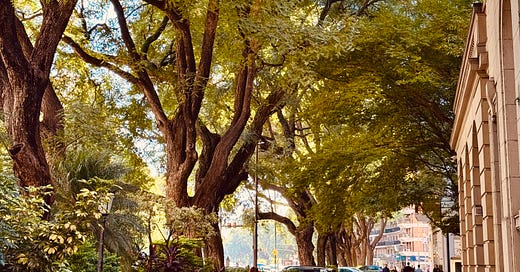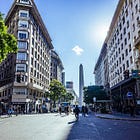Moving to Buenos Aires in 2025: 7 Things You Should Know Before Coming
We cover the essentials to help you settle in without losing your mind or patience.
So, you’re planning a move to Buenos Aires with big expectations of a city with European charm, Latin American energy, and a new adventure at every turn. But living here isn’t quite the same as visiting. The city is thrilling, yes, but it’s also unpredictable, layered, and potentially frustrating for newcomers. This guide isn’t about selling a fantasy; it’s about giving you the inside scoop, from navigating apartment hunting to where to shop. Whether you’re moving for love, work, or a change of pace, making a temporary or permanent move, it covers the essentials to help you settle in without losing your mind or your patience.
1. Getting Residency, Or Not
Most tourists are allowed to stay in Argentina for 90 days. This can officially be extended for another 90 days at the Departamento Nacional De Inmigraciones — just make sure to apply between days 80 and 90 of your current visa. The other traditional option for extending a stay was to make a “visa run” to Colonia and get a fresh 90 days after spending the day across the river in Uruguay. And a love story was usually enough to convince any quizzical officers to issue a new visa. However, recent tightening of illegal immigration could mean the end to this, or at least more intense questioning from immigration when coming back into the country.
There was also a time when overstaying was almost fashionable and was punished by a light verbal warning and a modest fine of around US$ 12 (early 2009). This was a bargain for hanging around long past your welcome. Mingle long enough in digital nomad circles and you’ll hear stories of people doing this for a decade or more. On the flip side, there will be murmurs of a three-strikes-and-out rule, where people are denied entry when returning after overstaying for the third time. It seems to all come down to the discretion of the immigration officer on the day.
For those planning a longer stay, there are legitimate paths to residency. These include marrying an Argentine citizen, being the parent of a locally born child, or landing a job with a formal employment contract. Student and retiree visas are also available, each with its own paperwork trail. And then there’s the elusive Digital Nomad Visa, introduced to attract freelancers earning income abroad. It allows a 180-day stay, renewable once, and requires proof of income and professional credentials. There is also the rentista visa, which allows you to become a temporary resident if you can prove a passive income. In every case, bring patience, persistence, and a knack for navigating bureaucracy with a smile.
2. Renting Without Getting Ripped Off
Renting in Buenos Aires can be akin to dating someone charming but unreliable — it can work out beautifully, but you’ll need to keep your wits about you. For short stays, AirBnBs and furnished temporary rentals are the easiest route. They’re more expensive, but they bypass any red tape and sometimes include utilities. For longer stays, many expats turn to Facebook groups, real estate websites, or even WhatsApp chains to find local landlords. It pays to be cautious, though. Scams do happen, and “fully equipped” might turn out to be one fork and a mattress on the floor. So, arrange to view the apartments before committing..
If you’re trying to rent long-term through a traditional agency, brace yourself for the dreaded garantía — a local property owner who agrees to back your lease. Without one, many landlords won’t even consider you. You’ll also be tying yourself into a three-year contract, the standard for long-term agreements. Alternatives like paying several months upfront are possible, but not always accepted. In most cases, foreign renters will find more flexibility with private landlords than real estate agencies.
Short-term rentals: 4 Rent Argentina and ByT Argentina.
Facebook Groups for rentals: Alquiler Dueño Directo, Buenos Aires Real Estate and Buenos Aires Classifieds.
3. Inflation and Currency Survival Tips
There’s no denying that Argentina is a financial rollercoaster, long characterized by its volatility and dramatically fluctuating inflation rates. In 2024, the country experienced an annual inflation rate of around 118%, a significant decrease from the estimated 211% reported in 2023. As of April 2025, monthly inflation has slowed to 2.8%, bringing the annual rate down to 47.3%.
Currency exchange rates are also a mystery, going from being tied to the US dollar during the 1990s to AR$100 worth a little over 10 cents today. Tighter currency restrictions around 2011 saw the infamous "dolar blue" (an unofficial exchange rate) gain prominence. Tourists with hard cash could often get up to double when exchanging at “cuevas” (informal exchange houses) instead of official means. This made Argentina somewhat of a Shangri-La for foreigners. Nevertheless, recent government reforms have narrowed the gap between official and blue rates to a bare minimum, thus raising the cost of living in dollars.
For residents and newcomers alike, living here necessitates adaptability. Locals will tell you that it's cyclical and that the heady days of the dollar blue could well return. Either way, getting your head around daily price changes and making budget adjustments is part and parcel of living here.
Ambito is a useful source for checking exchange rates and fluctuations.
4. Where to Grocery Shop
Grocery shopping in Buenos Aires is a balancing act between convenience and character. Big-name supermarkets like Coto, Carrefour, and Disco offer one-stop shopping, but tend to be pricier, especially for the limited range of imported goods. They do, however, run regular ofertas (sales) and discounts for loyalty card holders. Just brace yourself – when deals drop, the checkout lines can stretch longer than a Sunday asado invitation list, especially at the beginning of the month and weekends.
On the flip side, shopping local is where the city shines. Neighborhood verdulerías (greengrocers), carnicerías (butchers), fiambrerías (delicatessens), and almacenes (corner stores) often offer fresher goods and better prices, in addition to a good old-fashioned chat. Cash payments are usually rewarded with discounts, too.
For health nuts and gluten-dodgers, dietéticas are little havens selling seeds, bulk grains, granola, organic shampoos, and weird teas you didn’t know you needed. Finally, look out for the Ferias de la Ciudad. These daily markets have specialist fresh produce, meat, fish, cheese, and household products vendors, meaning you can do all of your local shopping in one place. Check the days, times, and locations here.
5. Understanding Local Work Culture
Working in Buenos Aires comes with its quirks, comforts, and complexities. The job market can be challenging for foreigners — competition is high, and most employers favor bilingual candidates and either Argentine nationals or permanent residents. Salaries are mostly paid in pesos, which means your income will rise and fall with inflation and the exchange rate. Those contracted from abroad might have a better chance of getting higher salaries or even being paid in a foreign currency, though there is no guarantee. The employer is also likely to help with visa and/or residency arrangements, allowing you to skip some bureaucratic hassle.
Full-time employees typically work a minimum of 40 hours per week. They are given 14 days paid annual leave—a healthy number for those accustomed to US vacations but low for European standards. There is the added bonus of a ton of public holidays (19 in 2025). And, on top of the standard salary, all employees are entitled to an aguinaldo. This is an annual bonus, or 13th-month salary, split between June and December.
Quitting? You’ll need to send a Comunicación de Renuncia resignation telegram. Yes, a telegram – as if you’re announcing your departure from the Western Front. It’s a legal formality, but one that’s still oddly required in the age of email. The form is available at all post offices and via the Correo Argentino website.
6. Healthcare and Insurance Basics
Argentina’s healthcare system is a three-lane highway: public, private, and union-run (obra social). In Buenos Aires, the public system is technically free for everyone, even foreigners – whether the current government keeps it that way is unknown. Regardless, you’ll be met with long waits and varying quality. It’s a decent backup, but ultimately not ideal for day-to-day care.
Most expats opt for pre-paid private insurance, with Swiss Medical, OSDE, Galeno, and Medico being some of the major options. These insurance plans grant access to a wide network of citywide clinics and hospitals with modern facilities and faster appointments. Payment plans vary, with the higher-tier options covering everything from surgeries and dental care to aesthetic treatments. Prices, like everything here, are at the mercy of inflation.
You don’t need proof of insurance to live in Argentina, but it’s wise to have coverage for anything beyond a routine check-up. Pharmacies are plentiful and typically cheaper than abroad, but it’s worth stocking up on any essential medication before arriving. You never know when your brand might disappear or be en falta, which means “out of stock with no idea when it’ll be back, so good luck.”
7. How to Build a Social Life
Porteños are famously open and friendly, but also incredibly tight-knit in their inner circles. Making friends here isn’t impossible, but it can take a little time and cultural fluency. You might not get an invite to someone’s birthday party after your first coffee together, but stick around, stay curious, and be prepared for last-minute plans and even later cancellations. And once you've been added to the WhatsApp group, you’ll need to master managing 135 simultaneous conversation topics all day, every day.
Coworking spaces like La Maquinita or AreaTres are popular among local and international freelancers. And Mundo Lingo arranges regular conversation meetups around the city, usually in bars where beers and fernet encourage the flow of conversation. If fútbol is your game, you can join pickup games with an international crowd via FC BAFA. Or look for teams advertising for players in the Comunidad section of Hoy Se Juega. Foodies Buenos Aires has frequent group events, and The Classic Sports Bar on Plaza Armenia has become a popular hub for watching European and North American sports.
Check out some more Buenos Aires information with our Buenos Aires Travel Guide for first-timers.






